|
- Catalog (in stock)
- Back-Catalog
- Mail Order
- Online Order
- Sounds
- Instruments
- Projects
- History Face
- ten years 87-97
- Review Face
- our friends
- Albis Face
- Albis - Photos
- Albis Work
- Links
- Home
- Contact
- Profil YouTube
- Overton Network
P & C December 1998
- Face Music / Albi
- last update 02-2017
|
African music is nearly always coupled with some other art form, such as poetry, ritual or dance, and it constitutes one of the most revealing forms of expression of the African life and soul. They have a sense of rhythm. Some tribes combine dance and music, and they explain history and the social elements in a form like the theater of today. Dances were most of the time closely related with religion, ancestral worship and spiritualism.
We have to understand that there is an interaction between social and cultural background within different communities in Uganda. Every community or tribe has its own religious beliefs. All rituals are organised, with dances being performed by communities in order to worship or appease the gods, in order to ask for a good harvest before sowing, at the occasion of midsummer or midwinter festival, or just on the occasion of entering a new lunar phase. Or if there was need of rain. The gods were asked for fertility, or the people tried to appease the demons or diminish their influence. Everybody was invited to be present to honour the situation and to thank the gods.
These dances are part of everyday-life, they are old traditions, handed down from generation to generation, with a deep cultural background being present in a ceremony or a ritual to thank the gods, or they can constitute a local social interaction, such as the wedding party or the burial ceremonial for an important personality; courtship dance to bring together the new pairs, or ritual dances for a boy becoming a man; or it could simply be a gathering leading to a party with dance, or there has been arranged a party for guests, etc. Dance is also expression of joie de vivre.
|
Baganda people
Nankasa, Baakisiimba, Muwogola - This is a social gathering dance of the Baganda people.
Is a traditional folk dance that originated in the palace of the King of Buganda, situated near by the Lake Victoria, the home of Nalubaale, the wife of Lubaale, one of the gods of the Baganda people.
A former Bugandan king (kabaka) greatly enjoyed the local beer, tonto omwenge. Tonto is made from banana plants, and the name is taken from the Lugandan word tontomera, which means, "Do not knock me over".
At one gathering, this king drank too much of the beer and became quite happy. (In Buganda, it is taboo to say that the king is drunk; you can only say that the king is very happy.) The king then started praising the people who had made the beer, saying abaakisiimba, which means "those who planted the bananas", and bebaakiwoomya, "they made it delicious".
The musicians at this gathering created an abaakisiimba rhythm that imitated the words of the king, who was so happy and relaxed that he began to move and dance. While the musicians mimicked the king's words on their drums, the women imitated the king's movements, which eventually became a dance that is now performed throughout Buganda by all generations. There are three major movements in this dance: the first is Nankasa, the second is Baakisiimba, and the third is Muwogola.
|
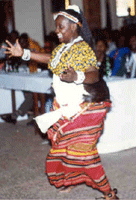    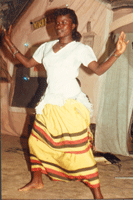
|
Amaggunju - This is a royal dance of the Baganda people.
Is a folk dance of the Baganda that also developed in the palace of the king.
At one time King Mulondo died without leaving any heirs. Fortunately, he left behind many wives who were expecting, so the medicine men and traditional witch doctors urgently searched for a wife who was pregnant with a boy. (It was taboo for the kingdom to be ruled by a woman). One of the wives, Namulondo, was expecting a boy, so she sat on the throne, and the people understood that it was not her who was ruling, but her unborn son. When this prince was born, he ruled as he lay on the throne. Kings in Buganda, however, are not supposed to cry, as this would bring curses and bad luck to the kingdom. Therefore the uncles and aunts of the young prince created the amaggunju dance to keep the baby smiling. The men put "ankle bells" on their legs, and the sound that the bells made as the men danced kept the prince happy. Originally, this dance was only to be performed by people of the Obutiko or Mushroom clan, and only in the palace.
Mbaga - This is a wedding dance of the Baganda people.
This folk dance is performed in Central Uganda by girls who have reached the age of 18 years in order to prepare them for the task of being a wife, mother and nurse and teacher of children in their marriage.
In the text, the bride is informed on her future role as wife and mother, she is given information about the duties and tasks she has to perform in her furture marriage; how she is to serve her future husband, to give birth to children and raise them; how to manage housework, doing the laundry, and also working on the fields. These tasks are depicted in the dance by means of motives.
|
Basoga people
Tamena Ibuga - This is a harvest celebration dance of the Basoga people.
Is a folk dance from the Busoga region in eastern Uganda. This dance is a sign of friendship and unity. Once there were two men who were such good friends that they shared everything in their life. One day, they went out to drink beer, which is traditionally served in a gourd. When they had had too much to drink, they began to argue, and this developed into a fight. The gourd that they were drinking from was broken in the fight, making matters worse and separating these two friends. The men's community recognized that a quarrel between these men would break up their friendship and affect the unity of the community, so they developed a dance to unite the people.
- This folk dance is still performed on the occasion of the harvest festival of the Basoga people.
This folk dance asks the community to not stop harvesting. In this dance, the cultivation of the lands and the good harvest are being praised. There is dance shaking the hips, without stopping. The neighbours say that the dancers are fortunate not having to stop shaking their hips and being able to dance with their hips. Men and women, young or old ones, love the locally brewed beer and the dance of shaking hips. This dance triggers emotions of happiness; the dancers must not stop monitoring the harvest, drinking beer and dancing.
|
Bagisu people
Mwaga - This is a ritual song of the Bagisu people.
Is a ceremonial initiation dance of the Bagisu people, who live in eastern Uganda on the border to Kenya. They believe that for a young boy to become a man, he must be circumcized in a ceremony that is reflected in the dance.
Before this initiation, the young boy must dance for 21 days, and only then will he possess the spiritual powers with no fear and become a man. If a man, even an elderly one, does not go through this ceremony, he will never be referred to as a man, and he will never earn the respect of the community. He will actually be cursed until the spirits force him to perform this ceremony.
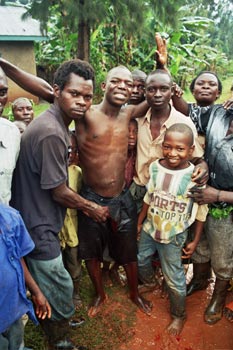 |
The Bamasaaba (Bagisu) are famous for their traditional male circumcision ceremonies, held every year. This ceremony is an important cultural link between the local people around Mt. Elgon. Today during the three-day-ceremony of dancing, visiting friends and family, feasting and receiving gifts, preceded by a couple of months of preparations, e.g. bamboo strips being handed down to the candidate by the eldest uncle on the father's side in order to symbolize the responsibility and strength needed to face the challenge of manhood, the candidate is decorated with skins and waves two black and white colobus monkey tails in the air as he is accompanied in his running across villages. A combination of sounds, including the ringing of bells attached to the candidates, fiddles, flutes, and group songs, makes this event memorable to anyone watching. Intricate rhythms are played on different traditional drums of differing pitching, and this creates and often stimulates the dancing of everyone present. The person undergoing circumcision is accompanied in the running across the villages, and at the end of it he must be strong and he is not expected to make noise (scream) during circumcision, as otherwise the family will be very embarrassed. It is of great importance for the candidate to "quietly" stand strong during the circumcision to show that he is capable and ready to become a man. The initiates are admitted into adulthood after this ceremony and are expected to begin their formal contribution to the growth of their respective communities. Unlike the Bagisu, the Sebei also circumcise women. |
|
|
|
Iteso people
Akogo - This is a courtship dance of the Iteso people.
Is a courtship dance from the Teso region in northeastern Uganda. This dance shares characteristics with the Larakaraka ceromonial dance from the Acholi, and it is similar to the Runyege courtship dance of the Batooro. The music for this dance, however, is played more softly on melodic instruments such as the thumb piano (akogo) and the flute (endere).
In the first verses of this dance song, all members of the community are invited to participate in this courtship dance of the two lovers in order to be witnesses. Also other participants have the chance to find partners for marriage in this dance. The melody „call to the courtship dance“ is closely associated with sociality and fun for all participants.
|
Acholi people
Bwola - This is a war dance of the Acholi people.
Is also a court dance (in the king's palace) of the Acholi, which live in the north of Uganda. This is a circular dance that is performed by the older men and women, and the circle represents a fence that surrounds the palace court. Many events and conversations take place during this dance, so it may last for many hours.
It is performed at the royal court to show how men can protect all the people in their communities from evils that might attack them. It is done in a cirular form with dancers and singers, both young and old in a first circle inside.
The outer circle is always composed of strong men (warriors) who perform movements of bravery, shouting determination to die fighting anyone who invades their community. All songs praise the men (warriors) who are as tough as lions.
|
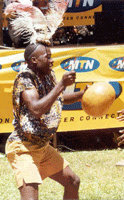
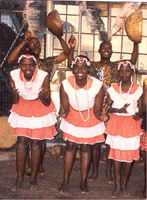
|
Larakaraka - This is a courtship dance of the Acholi people.
Is a ceremonial dance from the Acholi, who have borders with the Sudan. It is primarily a courtship dance that is performed during weddings. When the young people in a particular village are ready for marriage, they organize a big ceremony where all potential partners meet. As a sign of friendship, food and alcoholic drinks are served during this ceremony. Only the best dancers will get partners, so there is a lot of competition during the dancing. In Acholi, if you are a poor dancer, you are likely to die as a bachelor.
In this song, children, teens and also the elder generation are called to gather together in order to celebrate the annual courthip. In this song there is explained how one can attract girls in order to make them fall in love and later on marry them. There is further given an explanation how important a good character is for a good marriage, how future wives are found for a responsible and good partner, and how these futher wives are to be treated in their marriages.
When teenagers make the experience of the harmony in this dance, then they believe that their dance partner will also make a good partner for their life.
Ding Ding - This is a social gathering dance of the Acholi people.
This is also a children play dance, and it is performed, when the sky in the Acholi land hosts the full moon. On the occasion of this, the children are not able to sleep early, as they are kept awake by the bright moonlight; they stay in their parents‘ courtyard and play. The run around and blow the wunderful whistle, which also attracts the neighbouring children who come along. Under the bright moonlight, the girls sing and dance, integrating everyday motifs and movements like jumping, bouncing and shaking their hips into their dances. Late at night, however, everybody will become tired and go to bed.
- This dances is performed by the young girls of the Acholi. The girls dance in order to attract the boy’s attention.
|
|
|
Lugbara people
Gaze – This a traditional dance of the Lugbara people from the region of the West Nile in the north.
This dance reflects the transition of the dance movements into those of their neigbors in the Congo style.
This is a children’s dance. It tells of their everyday life. They are still young and thus flexible. They are active and burst of energy.
|
Agwara - This is a social gathering dance of the Lugbara people.
Is a dance of the Lugbara and Kebu people in the West Nile region, bordering the Congo and the Sudan. The dance got its name from the agwaras, the local trumpets. The men play these horns as the women dance.
Members of the cummunity are called to come together and participate in this dance. The name goes back to an instrument, the „agwara“, a transversely blown horn, the sound of which being similar to that produced by flies.
A story tells that many years ago the western Nile region was home to a very fast animal, living in the woods: the okapi, sometimes also called the forst giraffe, is a cloven-hoved animal of the family of the giraffid; it could not be hunted and killed by the hunters. Several months later, hunters found such a cadaver, covered by flies.“ngaanaaa” – this sound produced by the flies was similar to the sound of their trumpet „agwara“, a horn made of wood, wrapped by animal skin. This instrument is used as a signal horn and for playing melodies. Together with drums, it accompanies a dance; a dance imitating the movements of the hunters, who carefully sneak up in order to not frighten off the animals.
|
|
|
Alur people
|

|
Otwenge - adungu dance
Literally means "elbow". It is a song of the Alur people in the northwestern West Nile region, and in this song the adungu (bow harp) is commonly used. The bow harp dance is for the talented young boys and girls of their community. The song is played on the adungu, and it emphasizes the importance of the elbow. The dancer’s body uses the motifs and movements of the elbow. |
 |
|
Batooro people
Runyege - Entogoro - This is a courtship dance of the Banyoro people.
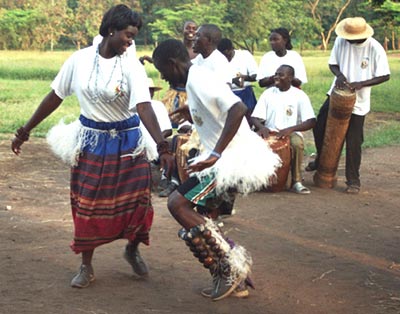
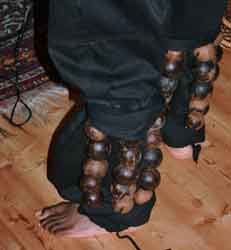 |
This is a ceremonial dance of the Bunyoro and Batooro Kingdoms. It is also a courtship dance performed by the youth when it is time for them to choose partners for marriage. The dance was named after the rattles (binyege / ebinyege / entongoro) that are tied on boys' legs to produce sounds and rhythms. The sound produced by rattles is more exciting as it is well syncopated as the main beat is displaced but everything blends with the song and drum rhythms.
In this culture, people believe that the best dancer represents the best married life. Once upon a time, there was a problem in the Kingdoms when more than 10 men wanted to marry the same beautiful and good-looking girl. What happens is that a very big ceremony is organized and all the male candidates have to come and dance. The girl had to choose the best male dancer. In this culture it is believed that the best dancers also show the best marriage life. It is also to see who is the strongest among the men as families in Africa do not want to give their beautiful girls to weak men, for when there is a period of drought or famine, one should have a husband who will really struggle to see that he looks for water and food. So in this dance the man who gets tired first, loses first and that who dances till the end wins the game. There was a problem when some girls wanted to get married to particular men and these were the men who got tired first - what a pity! The girls did not have a choice, as their parents decide for them whom to marry. The dance also indicates who is the strongest man, and families do not want to give their beautiful daughters to weak men who will struggle to provide food and water when there is a drought. So in this dance, the man who gets tired first loses, and the man who dances until the end, wins. A girl may want to marry a man who gets tired early in the dance, but she has no choice but to marry the winner. |
Empango -This is a worship dance of the Batooro people.
This dance is like a procession and worshipping ceremony for the king. The king who is like a god is shown deepest respect. In this way, respect is also shown to the royal family as well as the entire court.
Such a ceremonial dance is also performed in other royal palaces by the king’s subjects in great grace.
|
Banyankore people
Ekitaguriro - This is a harvest celebration dance from the Banyankore people.
This dance comes from the Ankole region. It is an old dance for both men and women. It is occasionally performed to demonstrate the love of the Ankole people for their cattle. This cattle breed has very long horns so making the dance aerial. The singing in this dance is similar to the sounds of the cow. You can even hear the sounds of the milk flowing from the udder of the cow in this dance. The flute that is played during the dance is the same that is used to herd cattle. The stamping movements of the men in this dance are similar to the walking movements of a cow, and the hands of the women just demonstrate the long beautiful horns of the cow.
These people include two tribes: the Bahima who breed cattles and are nomadic pastoralists and the Bahia who are farmers. However, the majority of the Bayankore are Bahima, the cattle breeders. It is them who perform this dance.
The dance appreciates the beauty of the cows which is why the dance songs start with heroic recitations, sounds of cows creating the melody. During the harvest and when the cows are grazing, the people play music and dance. The heroic variation appreciates the beauty of the cows and Bahima women.
|
|
|
Ekimandwa - This is a worship dance of the Bakiga people, whisch is still being dance by the Banyankore people.
This is a religous dance of the Bahiru people, a worship dance for the god Okubandwa. Kimandwa is derived from the word „emmandwa“ and means the spirits that people get possessed with during the dance performed in this ritual. They believe that sanity (sacrifices) and happiness (joy and love) which they present with this dance place god in a good relationship with the community.
|
Bakiga people
Ekizino - This is a harvest celebration dance of the Bakiga people.
The weather in this region is similar to that of many European mountain countries, and the region is often called the "Switzerland of Africa". During colder seasons, Ekizino is the warm- up dance. Kigezi is a hilly region, the men who go out for farming early in the morning, must jump around for a while to get warm and also stretch their muscles after the hard work. Traditionally, the people also used to stamp the ground until they found signs of water. Therefore, this dance represents their jumping and stamping.
The Bakiga dance also when they are happy, after a successful harvest, and when their storage chambers are fully stocked, with potatoes and onions.
After the men of the village have taken the harvest home, they go and visit other farms where there are then being hosted festivities where they eat and drink the locally brewed beer. As it is extremely cold, they dance and sing in order to overcome the chilly temperatures. While they are jumping up and down rather strongly, there are developed grooves in the ground. In this way, the strongest men show that they are the strongest. During the season to come, there will be provided the opportunity of revance; then they want to show their friends in their farmyards that they are able to jump even higher, making deeper grooves into the ground.
|
Karimojong people
Ekaro - This is a wedding dance of the Karimojong people.
This region has a high proportion of migrants from Kenya and the southern Sudan, who are married to Uganda people. They have remained to a great part nomads and pastoralists, frequently being involved in fights over their cattle. They have an aggressive character, which is typical for their nature and origin. The region is very hot and hilly. The Karamoya land has rich gold ressources, and, in spite therof, the region is only little developed. This region constitutes an interesting cultural area having strange dances and songs.
This song tells about a young Karimojong who falls in love with a girl. He takes her home and is ready to start negotations with her parents in order to make her his wife. The girl, however, rejects his proposal. But no other man will ever marry the girl as she no longer is a virgin.
|
Langi people
Ekoche - This is a courtship dance of the Langi people.
The Langi people are different from the Acholi in their dialect, even though they all live in northern Uganda. This dance song tells of the duty of the men to protect their country, their women and their property against invaders.
The dance is also about the fate of a Langi man who has trouble to find himself a wife.
Otole - This is a war dance of the Langi people.
As told in this war dance, men as well as women are ready to defend their tribe against an attack. Equipped with weapons like spears, axes and bush knives (pangas) and daggers, they are ready. The women support their men. They signal the attacks and provide their men with new weapons. Men as well as women defend themselves together against attacks in conflicts among the tribes in the north.
|
|
Owaro – This a ceremonial dance from the Samya-Bugwe region of Uganda. Samya is one of
the smallest populations in the country.
This is a „Welcome song“ in which the Samia people praise their happiness and the happy life they share. This song will be celebrated to start event, open ceremonies, gatherings etc.
|
| - see more about Traditional instruments of the Uganda people and - Traditional costumes of the Uganda people |
| - more information about regions you will find under projects: Uganda the country and the people |
Many thanks to Sarah Ndagire and Alfdaniels Mabingo from the Makerere University
in Kampala, Uganda for their helping with the texts.
Revised and translated by Hermelinde Steiner
|
|
